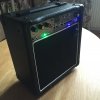No Probs Rorut.This is awesome! I will definitely make and use this one for all projects including lithium batteries. Can't thank you enough for all help and fast feedback spec! And I can admit I'm a bit jealous of all your knowledge
I will try to update my moser list with components above and post it here.
I dare say you have skills that I would be jealous of
Oddly enough, this was the architecture I started out with but chose the other architecture because it was simpler and gave more voltage drive for the PMOSFET, which is the critical aspect.
spec
Last edited:





